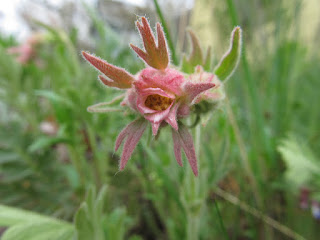
Just an update on what is flowering, and projects I am working on in the garden. It was such a nice day in Missoula, that I imagine a lot of people were out working in their gardens, too. This time of the year, things in the garden change so quickly, that I just wanted to capture what is happening now.
Our front yard prairie has the most color now. In the photo above, the electric blue of bluebells (Mertensia oblongifolia ) are in their peak.
Cutleaf daisy (Erigeron compositus) just started to flower.
Shooting stars (Dodecatheon conjugens) are still hanging on, but by the end of this weekend they might fade.
Arrowleaf balsamroot (Balsamorhiza sagittata) is just starting to show some color.
The first to flower in our little prairie, sagebrush buttercups (Ranunculus glaberrimus) are still hanging on, though most are in seed.
Prairie smoke (Geum triflorum) is also just starting to show signs of red.
We store garden dishes and glasses (thrift store dishes and glassware we only use for garden dining and entertaining) in the greenhouse, and I just re-purposed some old rake heads to serve as wine glass racks.The greenhouse is pretty barren right now, but there is a whole fleet of Thai peppers and eggplants growing steadily.
This is a sad composting area. For a few years, I have been meaning to rebuild our compost bin, and this weekend I finally did it. I am going to completely reorganize this area tomorrow. In looking at this photo, I realized we have a lawn mower, but no lawn. I think I'll Craigslist that tomorrow, or better yet, donate it to Home ReSource. By the way, Home ReSource is a great place to get a variety of gardening tools, materials and supplies- everything from lawn edging, to pots, irrigation supplies, shovels, to fencing. Just saying.
Sad compost bin. My wife, the compost maintenance supervisor, deserves better. But, this two bin composter has lasted us 12 years and has been moved all over the yard.
Canadian white violets (Viola canadensis) provide a lush ground cover in shady areas of our whole garden is just beginning to flower.
The white clematis (Clematis ligusticifolia), that covers so many arbors and trellises in our yard is just starting to leaf out.
The black capped chickadees that are nesting in our garden gather antelope hair for their nest box from a skull in our backyard. Antelope hair is hollow and a great insulator. We have a nestbox camera that we stream online- you can view the inside of their box here http://www.ustream.tv/channel/black-capped-chickadee-nest-box.




















